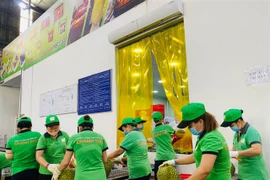This willhelp Vietnamese durian have sustainable consumption, according to the Ministryof Agriculture and Rural Development.
Chinais still the largest export market of Vietnamese durian, but this fruit productis mainly exported to China via border gates. Vietnam has not yet beenpermitted to officially export durian fruit to the market.
LeThanh Tung, deputy director of the Department of Crop Production, said that ifthere was no COVID-19 pandemic, the negotiations on official export forVietnamese durian to China would have ended in 2020.
Beforethat, the two countries completed the final steps in the negotiation process andalso prepared documents to sign the Protocol on the official export. However,everything had to stop because of COVID-19.
Accordingto the ministry, to give a licence on official export for fruit to China, amandatory requirement is that it must be from growing areas and packagingfacilities granted codes by the ministry. Those codes are approved by theGeneral Administration of Customs of China.
Chinais no longer an easy market. To promote sustainable agricultural productexports, the domestic agriculture sector needs to change the method ofproduction and export transaction, and promote quality control forfruit, including durians.
Despitethe COVID-19, China imported 809,000 tonnes of durian in the 11 months of 2021worth 4.13 billion USD, exceeding the figure of 2.3 billion USD in 2020. Thisis an attractive figure for Vietnamese businesses and gardeners.
Accordingto Ngo Tuong Vy, deputy director of Chanh Thu Fruit Import Export Company, toreceive the licence on official export, Vietnamese enterprises need to strictlycomply with regulations on traceability, which is having the mostproblems in Vietnam.
Besidesinvesting in appropriate infrastructure, the development of large raw materialareas and linkages with farmers are also being focused to meet thoseregulations.
Totake export opportunities, localities are negotiating and building adossier to be granted codes for durian growing areas.
InLam Dong, farmers have prepared all conditions, including product quality,linkage, building material areas and traceability stamps. to ensurestandards for export durian products.
LeThi Anh Tuyet, deputy director of Binh Phuoc’s Department of Agriculture andRural Development, said that the potential of exporting goods to Chinawas still very large but to enter this market, the products must have abrand, a planting area code and a packing facility code.
Manylocal businesses and farmers had realised this potential and had beenchanging their mindset to develop a production chain.
Thedepartment focused on support for farmers in developing coded material areas toexport fruits to China, she said.
BinhPhuoc province's agriculture sector has a roadmap to have official export forlocal fruits to China, including green-skinned pomelo and durian. The provincehas more than 3,000 ha of durian.
Thelocalities are gradually producing durian products having high quality,including high-tech durian production, and the building of raw material areasfor durians, according to the ministry.
Duriansdeveloped under VietGAP with a traceability stamp are sure to have the licenceof official export to China.
Theministry reported that Vietnam's annual durian output is estimated at 600,000tonnes.
Vietnamnow has about 50,000- 60,000ha of durian growing for official export, mainly inTay Ninh, Binh Duong, Dong Nai, Binh Phuoc, Tien Giang and Dak Lak provinces./.





























